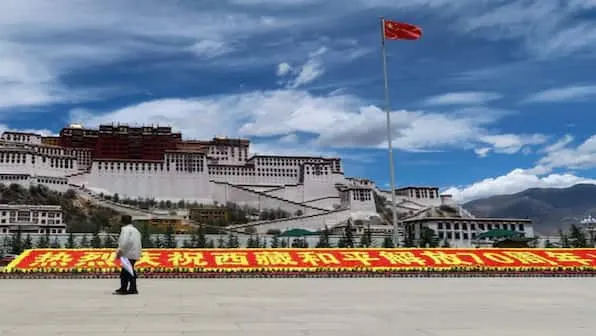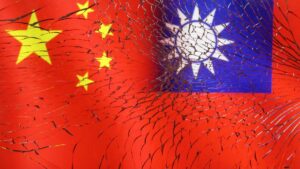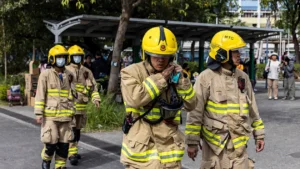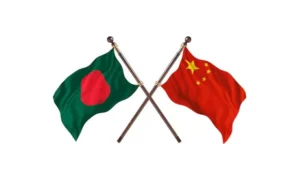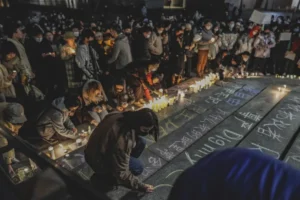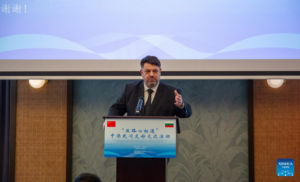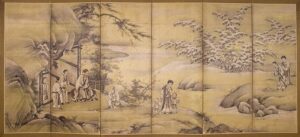What is US’ Island-Chain Strategy? Can it protect Taiwan from China’s aggression?
China’s aggression is at its peak as it sends bombers on May 24, 2024 to rattle Taiwan and warn its newly-elected President Lai Ching-te. A day before China had stationed 19 warships around Taiwan’s perimeter, 16 marine police vessels, and 49 warplanes, of which 35 crossed the medium line, all part of China’s war games to test its ability to crush Taiwan and seize power.
The goal was set straight by the Chinese President Xi Jinping a year ago when he directed his army to be ready for any kind of action by 2027. This gave clear indication to the world that Chinese premier was contemplating taking over Taiwan by 2027.
During the Korean War in 1951 the American foreign policy statesman John Foster Dulles formed the Island-Chain strategy. The strategy proposed encircling the Soviet Union and China with Western Pacific naval bases in the West Pacific to project power and restrict sea access. This plan was not a central issue during the cold war but it has remained crucial for America and China’s geopolitical status highlighting the strategic importance of Taiwan.
Now almost 73 years later, starting from May 23, 2024, China is again breathing down Taiwan’s neck through war drills near Taiwan’s border. The Ministry of National Defence, People’s Republic of China has issued a statement that Chinese PLA Eastern Theatre Command organized its army, navy, air force, and rocket force to conduct joint military drills surrounding the island of Taiwan in recent days to test its troops’ capabilities of joint operations.
In the current scenario, America’s Island Strategy has again come into focus. Today, the strategy involves a series of islands stretching from Japan, through Philippines and Indonesia, and down to Australia with strategically placed military bases and naval stations. Key US locations include Yasuka Naval base, Kadena Air base and Guam Naval Base in Japan. The Guam Naval base opened in the year 2020 is a critical hub to protect Taiwan which is strategically positioned near China.
China perceives America’s Island-Chain Strategy as a threat to its One-China policy and a hindrance to its right over Taiwan. On the other hand, US commitment to Taiwan’s defence further complicates relations with China. Therefore, the Island-Chain strategy plays a pivotal role in shaping up the power dynamics in the Pacific region serving US interests in maintaining regional safety while addressing the threats coming from China.
China’s military strength has risen manifold in the past few years. Under Xi Jinping’s leadership, China’s PLA has been busy modernizing its forces. Xi has pushed for a 7% increase in recent defence budget at the National People’s Congress of People’s Republic of China, the biggest hike in last five years. China aims to become a significant player in global security affairs. Its naval expansion in cyber wars has led to its growing influence in international security.
China has shown its rising prominence at the world stage by uplifting its military might. China’s growing assertiveness in the Western Pacific region has serious implication for regional stability. China tactics of building military bases on reclaimed islands, deployment of advanced military systems, and aggressive naval patrols highlights Beijing’s determination to assert its claims. These actions have sparked concerns of war among Southeast Asian nations and US allies who fear conflict over disputed territories. The increase in frequency of military encounters between the US and Chinese forces raises the risk of miscalculations that could escalate into larger confrontations in the region.
US’ Island-Chain Strategy plays an important role in containing China’s rise in the Indo-Pacific region. The US is implementing its first and second island chain strategies to leverage its military presence, strengthening alliance with the regional partners, and enhancing its defence capabilities. The first island chain refers to the first chain of major Pacific archipelagos out from the East Asian continental mainland coast extending the Kamchatka Peninsula in the northeast to the Malay Peninsula in the southwest. This chain includes the coral islands, the Japanese archipelago, the Rukyu Islands, Taiwan, the Northern Philippines and Borneo. A substantial part of the first island chain lies in waters claimed by China, including the East China sea, West of the Okinawa Trough, and South China sea within the nine dash lines. This chain forms a critical part of US strategy to containing Chinese expansion by creating a buffer zone and restricting China’s naval and air operations.
The second island chain encompasses Guan and the Northern Mariana Islands that reinforces the US defensive posture with strategic bases, missile defence systems, and over the horizon radars. It further comprises Japan’s Bonin Islands and Volcano Islands, Western Carolina Islands, Yap and Palau, and extends to Western New Guinea. The chain serves as eastern maritime boundary of the Philippines sea. This strategy’s primary goal is to restrict China’s access to the Pacific Ocean and limit its maritime movements. This containment strategy further helps monitor China’s intentions and ensures freedom of navigation in key sea lanes. The bases in the island chain serves as critical nodes for intelligence surveillance, reconnaissance, and power projection enabling rapid response to any emerging threats.
The defence of Taiwan is crucial for maintaining security in the First island chain as well as protecting South Korea and Vietnam. If China takes over Taiwan it would successfully breach the first island chain and would significantly shift the balance of military power in Asia in its own favour. PLA can further move to Philippines sea jeopardizing Japan’s southern flank and complicating cooperation between coalition forces. Taiwan is also busy strengthening its coastal defence. Taiwan has invested in 108 American M182 Abrams tanks, and is building eight submarines to beef up security. US is also bolstering its defences by deploying unmanned underwater vehicles, UUVs, smart mines backs by acoustic detection system.
There is growing call for the Taiwan to trust that the US and Japan, together, will defend it against Chinese aggression. China’s growing presence in Indian and Pacific oceans is a another pressing concern and the US, with the help of its ally India, is developing an interface to counter China and promote deeper ties in the region. In totality, US Island Chain strategy is the only means to counter China’s aggression and will come handy in case of a military escalation.


